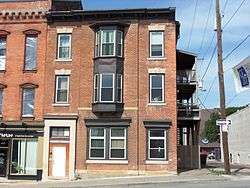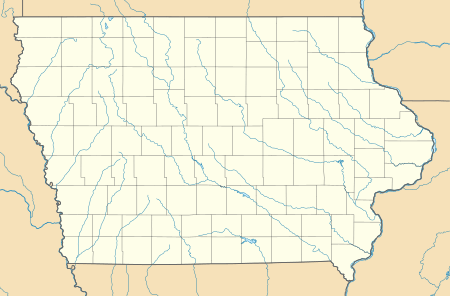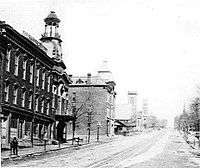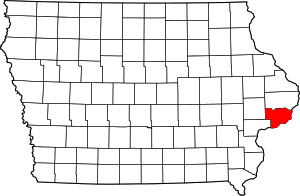Old City Hall (Davenport, Iowa)
The Old City Hall is located just north of downtown along a commercial corridor in Davenport, Iowa, United States. It was listed on the National Register of Historic Places in 1983.[1]
Old City Hall | |
 | |
  | |
| Location | 514 Brady St. Davenport, Iowa |
|---|---|
| Coordinates | 41°31′31″N 90°34′27″W |
| Area | less than one acre |
| Built | 1857 |
| MPS | Davenport MRA |
| NRHP reference No. | 83002479[1] |
| Added to NRHP | July 7, 1983 |
History

Designed by Davenport architect Willett Carroll, the building was built in 1857 as an engine house for a fire company.[2] That year the city council rejected sites along Washington Square and Court House Square for a new city hall, so in early 1858 the engine house's hall became the council chambers and other municipal offices were moved into other sections of the building. It continued to be used as a combination city hall and fire station until Hose Station No. 1 was built in 1877. A significant number of local industrialists and professionals served as mayor when this building housed city hall. They include George B. Sargent (1857), Ebeneezer Cook (1858–59), Hiram Price (1859), George H. French (1861-1862), John L. Davies (1865-1866), Michael Donahue (1867-1868), John C. Bills (1871, 1882, 1892), Ernest Claussen (1883-1889), and C. A. Ficke (1890-1891).[2] The building was converted around 1910 into an apartment building after the current city hall (1895) was built, and the structure was dramatically altered to its present appearance. When it was built it exhibited elements of the Italian Renaissance Revival style, and it included a tower on top of the east elevation.[3] While the structure is the oldest building in Davenport that is associated with municipal government and politics, it remains an apartment building.[2]
Architecture
The three-story, three bay, brick building was built on a stone foundation. In its present situation, the building combines several architectural styles.[3] The façade is dominated by a two-story polygonal oriel window that is ornamented with fleur-de-lis. The post and lintel entrance is on the left side of the east elevation, which is capped by a projecting cornice. The west elevation is topped with a half-hipped roof.
References
- "National Register Information System". National Register of Historic Places. National Park Service. March 13, 2009.
- Martha Bowers; Marlys Svendsen. "Old City Hall". National Park Service. Retrieved 2014-05-03. with photo
- "Old City Hall" (PDF). Davenport Public Library. Retrieved 2010-05-18.
